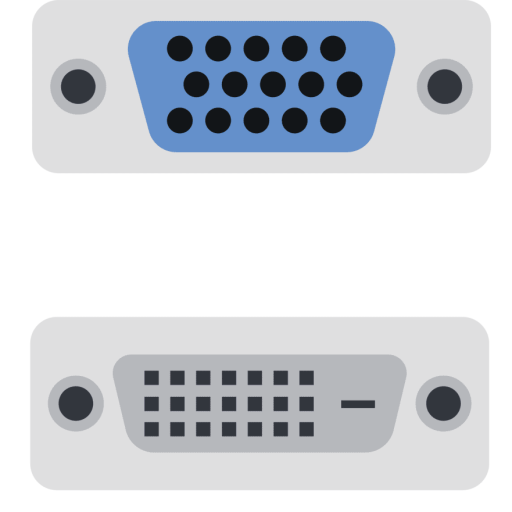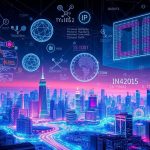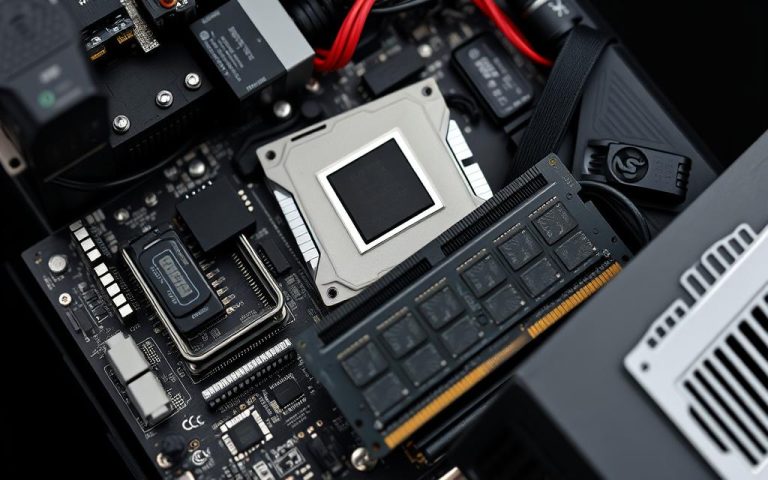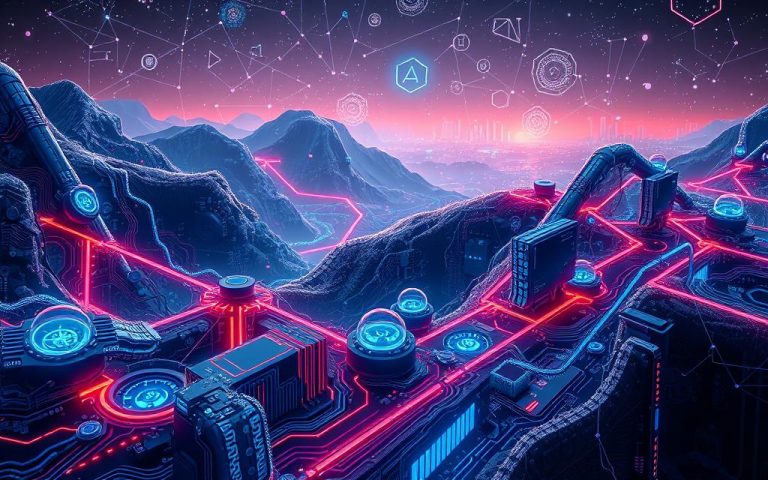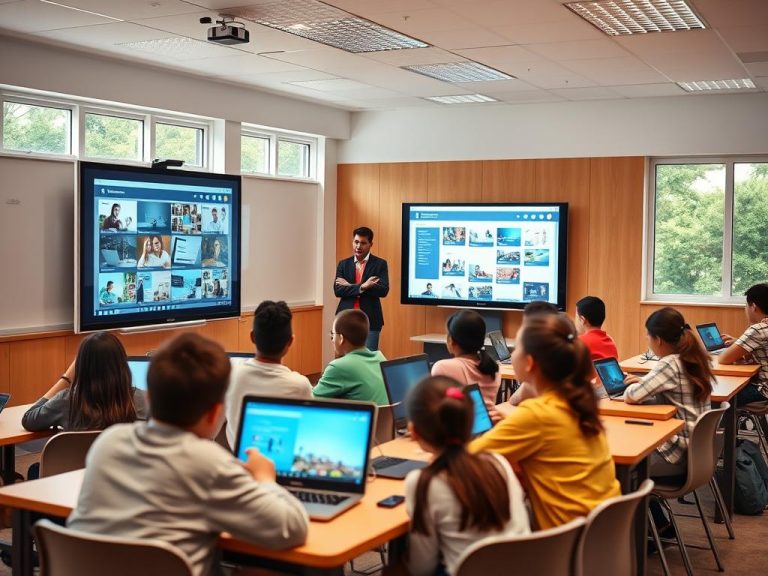The Many Ways Technology Improves Our Daily Lives
Modern advancements shape nearly every aspect of daily routines. From smart homes to telemedicine, innovations streamline tasks and create new opportunities. Over 58% of Americans now consider internet access essential, reflecting its deep integration into society.
The pandemic accelerated digital adoption, with 46% of remote workers relying on daily video calls. Workplace tools, healthcare platforms, and financial services evolved rapidly. These changes highlight the growing link between tech proficiency and career success, like mastering in-demand skills such as Java development.
Three innovation types drive progress: incremental upgrades, semi-radical shifts, and disruptive breakthroughs. Assistive devices demonstrate tech’s power to promote social equality, while AI tools redefine efficiency. Yet, this transformation comes with challenges—privacy concerns and digital fatigue remind us to find balance.
As the world embraces smarter solutions, understanding these impacts helps navigate the digital landscape with confidence.
How Does Technology Help People: An Overview
Processor speeds tell a story: 740 KHz in the 1960s to 5 GHz today mirrors our accelerated lifestyles. Over five decades, room-sized mainframes shrank into smartphones, with U.S. ownership jumping from 35% in 2011 to 85% in 2023. Moore’s Law fueled this miniaturization, packing more power into smaller devices.
The Evolution of Technology in Modern Life
Generational divides persist in tech adoption. While 69% of adults aged 18–49 deem it essential, only 38% of seniors agree. Rural areas lag, with 48% reliance versus 61% in cities. The pandemic narrowed gaps—81% of all ages embraced video calls, and 40% discovered new technological innovations.
Key Areas Where Technology Makes an Impact
Four sectors dominate transformation:
- Workplace automation: AI handles repetitive tasks, freeing time for creative work.
- Telemedicine: Remote consultations grew 300% post-2020, per Pew Research.
- Fintech: Mobile payments and AI-driven advice democratize finance.
- Smart cities: IoT sensors optimize traffic and energy use.
These advances redefine the way we live, work, and connect—proving tech’s role as a societal cornerstone.
Enhancing Productivity Through Technology
Efficiency gains from digital tools redefine workplace productivity standards. Automation slashes task time by 72% in manufacturing, while robotic process automation (RPA) cuts costs by 30% for most businesses. These advancements let teams focus on high-value work instead of repetitive tasks.
Automation and Efficiency in the Workplace
Enterprise resource planning (ERP) systems now power 89% of Fortune 500 companies. Manual data entry errors drop from 18% to 0.3% with automation. Platforms like Zapier save users 11 hours weekly by connecting apps seamlessly.
Amazon’s warehouses showcase scalability, deploying over 200,000 robots for logistics. AI schedulers like Clara Labs reduce meeting overhead by 40%, proving that smart tools elevate efficiency.
Time-Saving Tools for Everyday Tasks
The smart home market will hit $130 billion by 2025, reflecting demand for convenience. Grocery delivery apps reclaim 3.5 hours per household weekly. Using technology mindfully creates pockets of time for what matters most.
From AI assistants to cloud collaboration, these innovations help organizations and individuals thrive. The key lies in choosing tools that align with specific needs and goals.
Revolutionizing Communication and Connectivity
Digital bridges now connect continents faster than airplanes ever could. Over 2.9 billion people use social media globally, transforming how relationships form and thrive. Platforms like TikTok foster cultural exchange, with 3 billion downloads showcasing its role in global dialogue.
Social Media and Global Interactions
WhatsApp’s 2 billion users erase borders, enabling real-time family chats and cross-border business deals. Pew Research notes 65% of Hispanics rely on video calls daily—11% more than White users. Virtual events like Burning Man 2020 drew 8 million participants, proving physical gatherings aren’t mandatory for shared experiences.
Video Conferencing and Remote Collaboration
Zoom’s daily users exploded from 10 million to 300 million post-pandemic. Microsoft Teams supports 270 million professionals monthly, while VR spaces like Meta Horizon Workrooms redefine meetings. Language translation technologies further break barriers, making collaboration seamless across languages.
Business travel dropped 37% permanently as companies adopted these services. The shift saves time and reduces costs, proving that connectivity doesn’t require a suitcase.
Technology’s Role in Healthcare Advancements
Medical breakthroughs now arrive through screens and algorithms as often as in clinics. Over 46% of patients used telemedicine in 2023—up from 11% in 2019—proving virtual care is here to stay. These tools bridge gaps in *access*, especially for chronic conditions and rural communities.
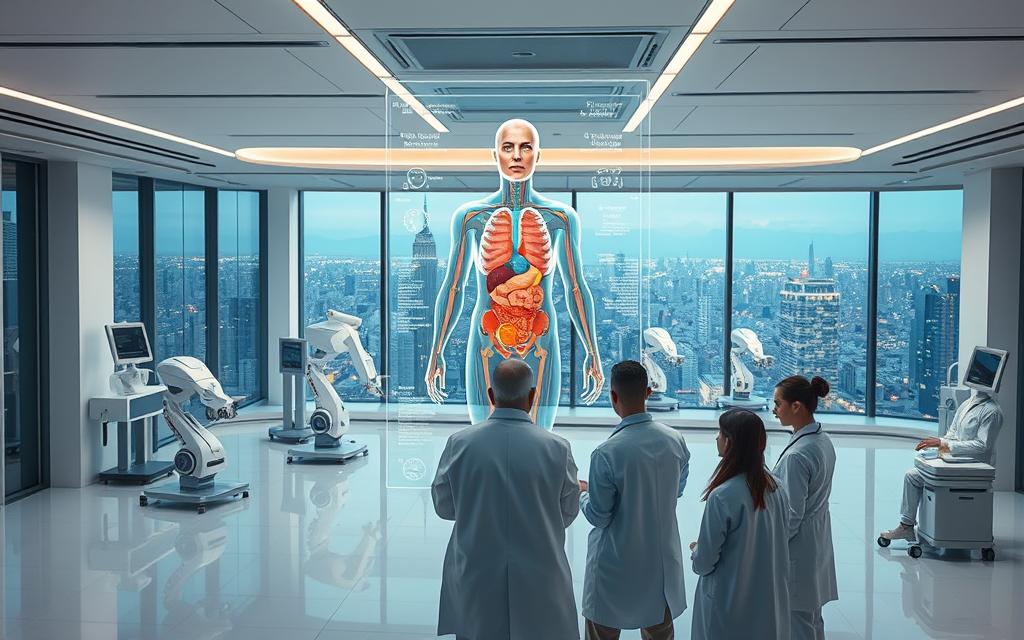
Telemedicine and Remote Patient Care
Teladoc visits surged 156% in early 2020 as lockdowns began. Remote Patient Monitoring (RPM) devices cut hospital readmissions by 38%, per CMS data. Wearables like the Apple Watch detect atrial fibrillation with 84% accuracy, alerting users before crises occur.
“AI mammography analysis achieves 94.5% diagnostic accuracy, rivaling radiologists.”
AI and Machine Learning in Diagnostics
FDA-approved tools like IDx-DR spot diabetic retinopathy early, preventing vision loss. Robotic surgeons operate with 0.1mm precision—three times finer than human hands. China’s 5G networks enable rural telesurgeries, democratizing specialized care.
| Year | Telemedicine Adoption | Key Driver |
|---|---|---|
| 2019 | 11% | Pilot programs |
| 2023 | 46% | Post-pandemic acceptance |
CRISPR gene editing and IBM’s Huntington’s disease research showcase *technologies artificial intelligence* pushing boundaries. From diagnostics to treatment, digital tools redefine what’s possible in health.
Transforming Education with Digital Tools
Classrooms today look nothing like they did a decade ago, thanks to digital innovation. Over 94% of U.S. schools now use smartboards, while global edtech investments soar toward $342 billion by 2025. This shift empowers students and teachers with unprecedented access and flexibility.
Online Learning Platforms and Accessibility
Coursera’s enrollment spiked 640% during the pandemic, proving demand for learning online. Yet, free MOOC completion rates linger at 15%, compared to 63% for paid courses. Platforms like Khan Academy bridge gaps, serving 135 million users with free lessons.
Adaptive algorithms, like Knewton’s, boost test scores by 35%. Schools also embrace 1:1 device programs, now in 98% of U.S. districts. These tools personalize education, catering to diverse learning styles.
Interactive Technologies in Classrooms
Augmented reality apps like Complete Anatomy engage 15 million students with 3D models. Google Expeditions takes VR field trips to 15,000+ schools, while LMS platforms streamline grading and feedback.
“Gamified courses increase engagement for 67% of students, making complex subjects approachable.”
The rise of smart classrooms reflects a broader trend: education isn’t just about memorization—it’s about interaction, creativity, and options.
Smart Homes and Everyday Convenience
Homes are getting smarter, adapting to our needs before we even ask. Over 67% of U.S. households now use at least two smart devices, from voice assistants to automated thermostats. These digital butlers learn routines and make energy-efficient adjustments, saving time and resources daily.
IoT Devices and Home Automation
Voice commands control 49% of American homes, with Alexa and Google Assistant leading the charge. The Nest Learning Thermostat cuts HVAC costs by 16% through pattern recognition. Home automation technologies rely on two main protocols:
| Protocol | Range | Best For |
|---|---|---|
| Z-Wave | 100m | Large homes |
| Zigbee | 20m | Low-power devices |
Whole Home Energy Management systems like Span.IO optimize power flow across appliances. Smart lighting adjusts brightness based on natural light, reducing electricity use by 30% in LEED-certified buildings.
Energy Efficiency and Sustainable Living
Smart irrigation systems slash outdoor water usage by 35% through soil moisture sensors. EPA studies show programmable thermostats save 23% on heating and cooling annually. These innovations support sustainable living practices while maintaining comfort.
“Demand response technologies prevent blackouts by automatically reducing home energy use during peak hours.”
From leak detectors to solar-integrated roofs, intelligent devices create homes that conserve resources effortlessly. The future promises even tighter integration between convenience and conservation.
Financial Management and Digital Banking
Digital wallets are reshaping how we handle money, making transactions seamless and secure. Venmo processed $230 billion in 2022, reflecting the massive shift toward mobile payments. This evolution gives users more options than traditional banking ever offered.
Mobile Payments and Security
NFC payment adoption varies globally—75% in South Korea versus 48% in the U.S. 87% of top banks now use biometric authentication like fingerprint or facial recognition. These measures enhance security while speeding up checkout processes.
Blockchain reduces fraud through transparent ledgers, with SWIFT GPI cutting cross-border payment issues by 52%. Real-time data validation prevents unauthorized transactions before they occur. Mobile banking users will reach 3.5 billion by 2025, proving this trend isn’t slowing down.
AI-Driven Financial Advice
Robo-advisors manage $1.4 trillion globally, offering personalized financial advice at lower costs. Betterment’s tax-loss harvesting algorithms save investors up to 0.75% annually. AI credit scoring faces scrutiny but improves access for thin-file borrowers.
“RegTech solutions slash compliance costs by 45%, letting institutions focus on customer needs rather than paperwork.”
Open banking APIs under PSD2 rules empower consumers to share data safely across platforms. Cloud computing enables scalable infrastructure for real-time portfolio adjustments. The future promises even smarter tools that learn spending habits and optimize savings automatically.
Technology in Transportation and Mobility
The roads of tomorrow are being paved with sensors and algorithms today. Over 124 million riders now use Uber monthly, while autonomous vehicles like Waymo have logged 20 million+ miles. This shift reduces urban congestion and creates smarter transportation networks.
Ride-Sharing and Vehicle Autonomy
Shared mobility services could cut personal driving by 80% through optimized routing. Two competing approaches dominate autonomous vehicles development:
| System | Accuracy | Cost |
|---|---|---|
| LIDAR | ±2cm | $75,000+ |
| Camera-only | ±15cm | $5,000 |
Tesla’s Autopilot shows promise, with NHTSA reporting 40% fewer crashes when engaged. Helsinki’s Whim app demonstrates Mobility-as-a-Service (MaaS) potential, integrating trains, bikes, and rideshares into one platform.
Intelligent Navigation Solutions
Real-time systems like Waze save drivers 15 minutes daily through crowd-sourced data. INRIX’s predictive algorithms analyze:
- Historical traffic patterns
- Weather impacts
- Special event volumes
China’s C-V2X networks enable vehicle-to-everything communication, preventing accidents at intersections. Emerging air taxis from Joby Aviation could soon bypass ground congestion entirely, with FAA certification expected by 2025.
“Vehicle automation may prevent 94% of accidents caused by human error when fully deployed.”
From pavement sensors to flying taxis, mobility innovations promise safer, cleaner, and more efficient journeys. The future belongs to integrated systems that anticipate our needs before we hit the road.
Boosting Mental Health and Well-Being
Digital tools now offer unprecedented support for mental wellness, breaking traditional barriers. Over 70 million people use mindfulness apps like Headspace, while teletherapy satisfaction rates hit 72%. These innovations make emotional support accessible anywhere, anytime.
Mental Health Apps and Online Therapy
The $2 billion meditation app market proves digital solutions resonate. Calm and Headspace lead with science-backed programs for anxiety and sleep. Clinical studies show:
- CBT apps improve outcomes for 68% of users (Happify data)
- 35% of users maintain meditation habits after 90 days
- VR exposure therapy reduces PTSD symptoms by 40%
Biofeedback wearables like the Muse headband teach stress management through real-time brainwave monitoring. FDA-approved VR treatments now supplement traditional therapy for phobias and trauma.
Reducing Stress Through Innovation
AI chatbots provide 24/7 support, with Woebot demonstrating 60% effectiveness in clinical trials. Talkspace partners with insurers to expand access, while wearables track physiological stress markers.
“Digital mental health services reduce treatment barriers by 83% through affordability and anonymity.”
From guided meditation to virtual support groups, these tools promote well-being on demand. The future promises even smarter solutions that anticipate emotional needs before crises emerge.
Technology’s Impact on Social Equality
Innovations are rewriting the rules of inclusion, creating opportunities where barriers once stood. The FCC’s Affordable Connectivity Program now serves 16 million households, proving that policy and tech can work together to close gaps. This progress addresses both rural isolation and urban affordability challenges.
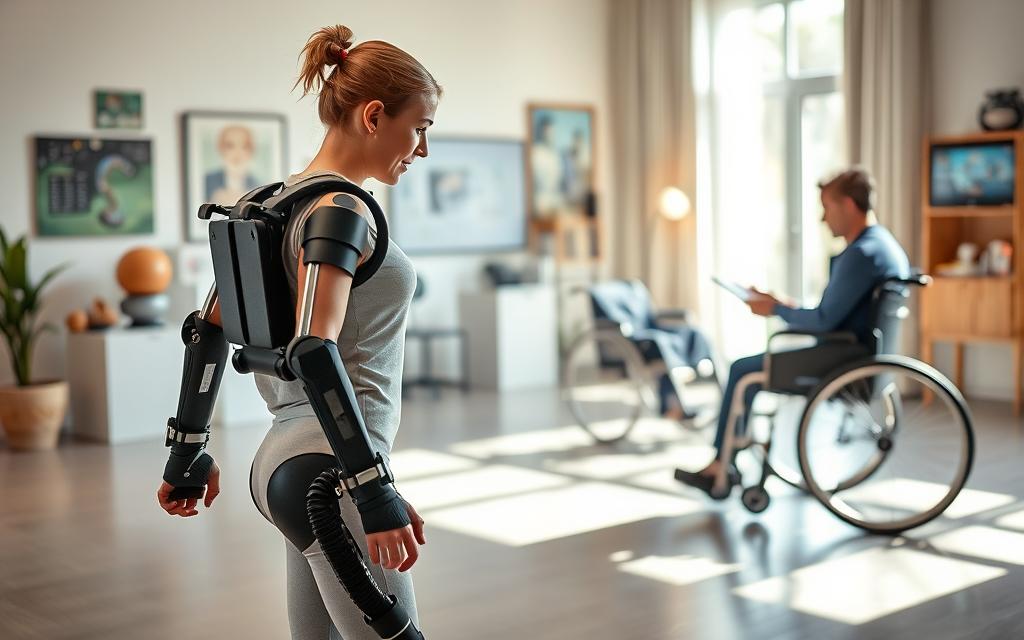
Bridging the Digital Divide
Global internet access remains uneven—93% in developed nations versus 40% in emerging economies. SpaceX’s Starlink network, with 3,000+ satellites, brings broadband to remote Alaskan villages and Sub-Saharan communities alike. Yet cost remains a hurdle, as highlighted by IEEE research showing low-income households trail in adoption.
The FCC’s new 100/20 Mbps standard sets clearer benchmarks for rural providers. Key disparities persist:
- Rural areas: 48% access vs. 61% urban (Pew Research)
- Minority students: 55% of disconnected youth during COVID-19
- Gender gap: Women 23-50% less likely to go online globally
Assistive Technologies for Disabilities
Screen readers empower 73% of visually impaired users to navigate the web independently. Apps like Be My Eyes connect 6 million volunteers with blind users through live video assistance. Breakthroughs in eye-tracking help ALS patients communicate using only gaze patterns.
“AI-powered captioning now achieves 98% accuracy, making digital content accessible to deaf users in real time.”
Project Loon’s legacy lives on through alternative balloon-powered networks for disaster zones. These tools demonstrate how thoughtful design can turn challenges into opportunities for social equality.
Entertainment and Leisure in the Digital Age
Screens now serve as gateways to boundless entertainment, reshaping leisure time globally. Netflix dominates 16% of internet traffic worldwide, while Disney+ streams 4K content to 150 million subscribers. This shift reflects changing consumption patterns—from scheduled programming to on-demand access.
The Streaming Revolution
Modern streaming services demand robust internet connections. Quality tiers vary significantly:
| Format | Bitrate | Data/Hour |
|---|---|---|
| SD | 3 Mbps | 1.35GB |
| 4K HDR | 25 Mbps | 11.25GB |
Dolby Atmos now enhances 85% of new film releases. Platforms compete through exclusive content and technical innovations, creating an arms race in home viewing quality.
Interactive Entertainment Frontiers
The PSVR2’s 600,000-unit launch demonstrates virtual reality‘s growing appeal. Notable developments include:
- Fortnite’s 250 million active players hosting virtual concerts
- Xbox Cloud Gaming reaching 10 million subscribers
- AR gaming market projected at $38 billion
“Travis Scott’s Astronomical concert drew 12 million concurrent viewers, redefining live experiences through game engines.”
From cloud-based gaming to metaverse events, digital leisure continues breaking creative boundaries. These advancements make entertainment more personalized and immersive than ever before.
Environmental Benefits of Technology
Cutting-edge solutions are tackling climate challenges head-on, proving innovation can heal the planet. Solar installations now power 23 million U.S. homes, while smart systems optimize resource use like never before. These advancements merge environmental benefits with economic gains, creating sustainable win-wins.

Powering Progress with Clean Energy
Perovskite solar cells achieve record 33.7% efficiency, outperforming traditional silicon panels. NREL reports an 89% price drop since 2010, making solar the cheapest energy source in history. Key breakthroughs include:
- Climeworks’ carbon capture plants removing 4,000 tons annually
- Battery storage costs plummeting to $132/kWh
- Google DeepMind slashing data center cooling bills by 40%
Offshore wind farms now generate renewable energy even during calm periods. Floating turbine designs harness stronger winds farther from shore. These innovations prove that clean power can meet growing demands without compromise.
Smarter Systems, Less Waste
Bigbelly’s smart bins cut collection trips by 50% using compaction and sensors. RFID sorting achieves 98% accuracy in recycling facilities, while apps like Too Good To Go rescued 130 million meals from landfills. Emerging solutions include:
| Technology | Impact |
|---|---|
| AI-powered water monitoring | Reduces utility leaks by 30% |
| Ocean Cleanup’s System 03 | Captures 10,000 kg of plastic daily |
“Advanced sorting technologies recover 92% of materials from e-waste, turning trash into valuable resources.”
From farm-to-table tracking to biodegradable packaging, smart tech reshapes consumption patterns. These tools prove that waste reduction starts with intelligent design and data-driven decisions.
The Future of Technology in Daily Life
Tomorrow’s innovations are already reshaping how we interact with the world around us. From quantum leaps in computing to neural implants, groundbreaking advancements promise to redefine human capabilities. These developments bring both exciting possibilities and complex ethical considerations that demand careful thought.
Emerging Trends Transforming Our World
Quantum computing moves closer to practical use, with 2030s commercialization timelines gaining traction. Early adopters in finance and pharmaceuticals could see 100x speed improvements for complex calculations. Mojo Vision’s AR contact lenses hint at wearable displays becoming invisible.
Space tech democratization accelerates with CubeSat constellations enabling affordable satellite launches. Neuralink’s FDA approval for human trials marks a milestone in brain-computer interfaces. Key areas to watch:
- Synthetic biology advancing medical treatments and sustainable materials
- EU Digital Services Act influencing global platform regulations
- Deepfake detection tools combating synthetic media risks
Navigating the Ethical Landscape
The EU AI Act sets strict compliance standards, with estimated €10M+ implementation costs for enterprises. Contrasting approaches emerge globally:
| Region | Focus | Impact |
|---|---|---|
| European Union | Risk-based regulation | Strict compliance requirements |
| United States | Ethical guidelines | Industry-led standards |
Privacy concerns intensify as emerging trends collect more personal data. Job displacement fears grow alongside automation advances. Thoughtful policy must balance innovation with societal protection.
“Global cooperation on AI governance will determine whether these tools divide or unite humanity in the coming decades.”
As technology integration deepens, proactive planning can maximize benefits while minimizing risks. The path forward requires equal parts vision and vigilance.
Balancing Technology Use for Optimal Benefits
Finding equilibrium in our digital lives has become essential for mental clarity. Americans now average 6 hours 58 minutes of daily screen time—enough to trigger “phantom vibration syndrome” in 68% of users. Smart strategies can transform tech from distraction to advantage.
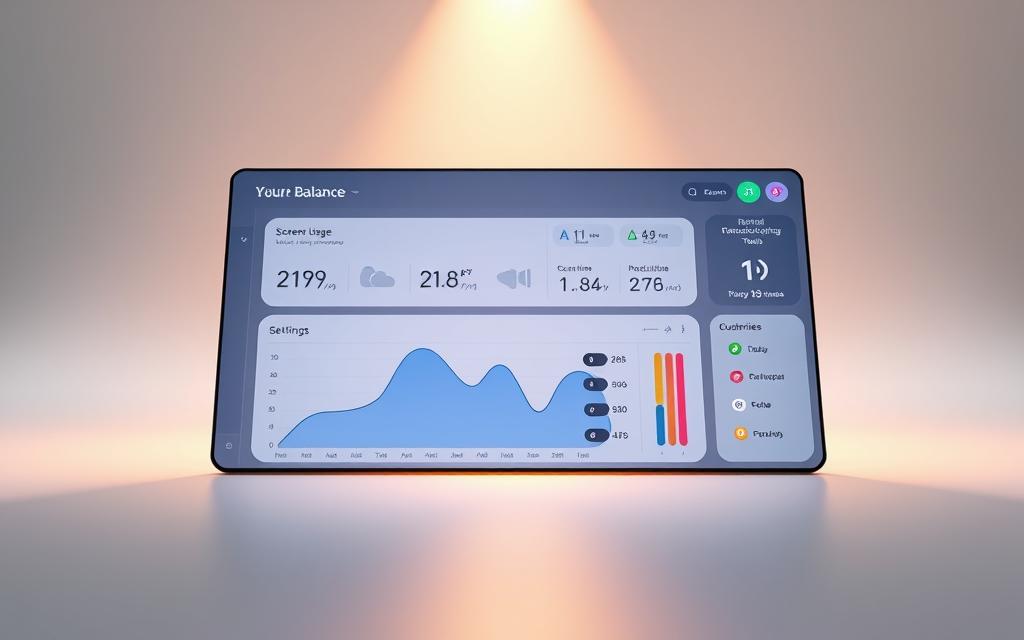
Setting Healthy Digital Boundaries
iOS Screen Time adoption reveals growing awareness, with 41% actively monitoring usage. Workplace policies evolve too—the EU’s right-to-disconnect laws protect personal time after hours. Effective approaches include:
- Designating tech-free zones like bedrooms
- Scheduling email checks rather than constant monitoring
- Disabling non-essential notifications
Digital detox retreats surged 300% since 2019, showing demand for structured breaks. Blue light filters demonstrate measurable impact, improving sleep quality by reducing melatonin disruption.
Mindful Tech Consumption Practices
The $1.5 billion focus app market helps users reclaim attention. National Day of Unplugging participation grows yearly as people discover benefits:
“Regular tech breaks reduce cortisol levels by 28% and improve cognitive performance metrics significantly.”
Practical steps include using app limiters and scheduling device-free meals. These mindful consumption habits create space for creativity and real-world connections.
By establishing digital boundaries, we harness innovation without sacrificing well-being. The goal isn’t rejection—it’s intentional use that serves our broader life balance.
Conclusion
Human potential expands through smart solutions. From healthcare to finance, innovations create new ways to live and work. Over 58% of Americans now see internet access as essential—proof of tech’s deep role in modern lives.
The future brings quantum computing and neural interfaces, but ethical oversight remains crucial. With 83% of experts endorsing tech-human partnerships, digital literacy becomes vital for everyone.
True progress lies in balance. When used mindfully, technology amplifies our capabilities without overwhelming them. The key? Adoption with intention, ensuring tools serve humanity—not the other way around.
FAQ
What are the main benefits of using tech in daily life?
Tech enhances productivity, improves communication, and provides access to vital services like healthcare and education. Smart devices, AI, and automation simplify tasks, saving time and effort.
How has digital innovation changed the workplace?
Automation, cloud computing, and collaboration tools like Slack and Microsoft Teams streamline workflows. Remote work is now easier with video conferencing and project management software.
Can tech improve healthcare outcomes?
Yes. Telemedicine platforms like Teladoc offer remote consultations. AI-powered diagnostics from companies like IBM Watson Health enhance accuracy in detecting diseases early.
What role does tech play in modern education?
Online learning platforms such as Coursera and edX make education accessible. Interactive tools like Google Classroom enhance engagement in digital and traditional classrooms.
How do smart homes contribute to convenience?
IoT devices like Amazon Alexa and Google Nest automate lighting, security, and temperature control. Smart thermostats also reduce energy consumption, cutting utility costs.
Are digital banking services secure?
Reputable banks use encryption and biometric authentication. Apps like PayPal and Venmo offer fraud protection, while AI monitors transactions for suspicious activity.
What environmental benefits does tech provide?
Renewable energy solutions like Tesla’s solar panels reduce carbon footprints. Smart waste management systems optimize recycling, minimizing landfill contributions.
How can individuals balance tech use for well-being?
Setting screen-time limits and using apps like Headspace for mindfulness helps. Prioritizing offline activities ensures a healthy relationship with digital tools.
